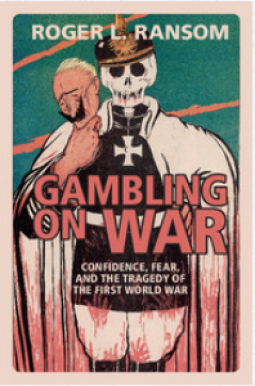
Gambling on War
Confidence, Fear, and the Tragedy of the First World War
by Roger L. Ransom
This title was previously available on NetGalley and is now archived.
Send NetGalley books directly to your Kindle or Kindle app
1
To read on a Kindle or Kindle app, please add kindle@netgalley.com as an approved email address to receive files in your Amazon account. Click here for step-by-step instructions.
2
Also find your Kindle email address within your Amazon account, and enter it here.
Pub Date Jul 01 2018 | Archive Date Jul 25 2018
Talking about this book? Use #GamblingOnWar #NetGalley. More hashtag tips!
Description
The First World War left a legacy of chaos that is still with us a century later. Why did European leaders resort to war and why did they not end it sooner? Roger L. Ransom sheds new light on this enduring puzzle by employing insights from prospect theory and notions of risk and uncertainty. He reveals how the interplay of confidence, fear, and a propensity to gamble encouraged aggressive behavior by leaders who pursued risky military strategies in hopes of winning the war. The result was a series of military disasters and a war of attrition which gradually exhausted the belligerents without producing any hope of ending the war. Ultimately, he shows that the outcome of the war rested as much on the ability of the Allied powers to muster their superior economic resources to continue the fight as it did on success on the battlefield.
Available Editions
| EDITION | Paperback |
| ISBN | 9781108600101 |
| PRICE | $27.99 (USD) |
Average rating from 4 members
Featured Reviews
 Reviewer 446033
Reviewer 446033
This book can be used in the classroom for political sciences, economic and WWI history classes. The author documentations the events with good references and focus on the economical factors that made last this horrendous war longer.
 Joseph S, Reviewer
Joseph S, Reviewer
Gambling on War: Confidence, Fear, and the Tragedy of the First World War by Roger L. Ransom is a study of the First World War through the eyes of an economist. Ransom is a professor of history and economics at the University of California, Riverside. He is the coauthor of the groundbreaking work One Kind of Freedom: The Economic Consequences of Emancipation.
Over the last few years piles of new books about World War I have been published. Since the 100th anniversary of the start of the war in 2014 to the coming anniversary of its end, this November, many books have reexamined the war that defined the 20th century. Perhaps one of the biggest advancements was in mobilization. Railroads changed the speed of the war. Industry (blood and steel according to Bismark) was modern warfare. Most wars of the previous period were those of colonization a power going against an undeveloped country. Although there was death, it was not on a grand scale. The American Civil War was a prelude of what was to come large-scale continued fighting and attrition.
World War I involved economic powers of Europe and nearly bankrupted them in the process. Ransom does something interesting in his thesis on the war. He looks at the war from an economic perspective. Bismark was a master of the "risk versus reward" in his early policies with Denmark and Austria-Hungary in unifying Germany. In addition to risk versus reward, fear plays a major factor in the upcoming war. Secret treaties were meant to offset fear of other countries. The previous balance of power that kept the peace was being eaten away by secrecy. It is not so much that alliances caused the war. Alliances are effective in keeping the peace when open. NATO is a prime example.
Ransom uses the Composite Index of National Capability Score to assign economic power to the warring nations. This is a more accurate indicator of power than GDP. These values change over time. Britain was the clear world leader in 1850. By 1914, The United States, Britain, and Germany were competing for dominance. By 1919 the US was the dominant nation and Germany was on level with Russia which was fighting its civil war, but still above a devastated France. Another telling aspect are the graphs used to show yearly imports, exports, agricultural production, GPD, and industrial out for each of the major combatants. Each country is a bit different in the way the war took its toll. For example, German imports crashed while Britain's imports skyrocketed. Austria- Hungary's graph plotted impending disaster.
Confidence and fear played a major role in the war. It was also a war no one wanted to fight but no one was able or willing to stop. Fear brought secret alliances. Unlike open alliances of NATO and the Warsaw Pact which kept the peace, secret alliances increased both fear and confidence. Fear of invasion created a need for allies; secrecy was needed to prevent possible enemies from forming their own alliances. Confidences as in Austria-Hungary knowing Germany would support and defend them from Russia were responsible for the actual start of the war. Gambling on War is an excellent look at the war through economics.
 Kyle R, Reviewer
Kyle R, Reviewer
This was a decent history of the First World War. It gives a broad outline of the course of the war in a generally acceptable manner. While not the best work on this subject, it's certainly not the worst. The book occasionally brings up interesting tidbits of newer scholarship, which is generally interesting.
As far as an economic history or "prospect theory," Ransom doesn't put much on the table. Gambles and Animal Instincts are occasionally tossed into the narrative, and there are some short sections on economics complete with a few charts. Yet, these are mostly just tossed into to competent but generic narrative of the war.
The book did succeed a bit in giving a bit of new perspective to the war in terms of sunk costs and gambles, but I feel like it is largely a superficial increase in knowledge.
If you're interested in brushing up on you're WWI history, with a bit of new information and an economic twist, then this book is ok. For those more well acquainted with the war, this is probably not a book that would interest you.




